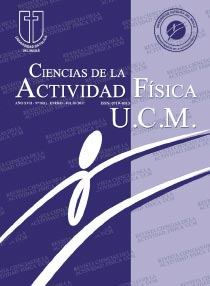Entrenamiento de resistencia muscular en jóvenes universitarios ¿método de oclusión vascular o tradicional?
Contenido principal del artículo
Resumen
Información del artículo
Publicado:
Dec 28, 2018
Sección:
Investigación
Palabras clave:
Restricción de flujo sanguíneo, Fuerza muscular, KAATSU
Detalles del artículo
Cómo citar
Bimbela-Villalobos, J. E., Suárez-García, M., Aburto-Corona, J. A., & Gómez-Miranda, L. M. (2018). Entrenamiento de resistencia muscular en jóvenes universitarios ¿método de oclusión vascular o tradicional?. Revista Ciencias De La Actividad Física UCM, 19(2), 1-9. https://doi.org/10.29035/rcaf.19.2.8
Referencias
American College of Sports Medicine. (2009). American College of Sports Medicine position stand. Progression models in resistance training for healthy adults. Medicine & Science Sports & Exercise, 34(2), 364-380.
American College of Sports Medicine. (2005). Manual ACSM para la valoración y prescripción del ejercicio. Editorial Paidotribo.
Baechle, T.R., Earle, R.W., & Wathen, D. (2000) Resistance training. In: Baechle, T.R. & Earle, R.W., eds. Essentials of strength training and conditioning. 2nd ed. Champaign, IL: Human Kinetics, p. 395-425.
DeWeese, B. H., Hornsby, G., Stone, M., & Stone, M. H. (2015). The training process: Planning for strength-power training in track and field. Part 1: Theorical aspects. Journal of Sport and Health Science, 4(4), 308-317.
Dankel, S., Jessee, M., Abe, T., & Loenneke, J. (2016). The effects of blood flow restriction on upper-body musculature located distal and proximal to applied pressure. Sports Medicine, 46, 23-33.
Fahs, C., Loenneke, J., Thiebaud, R., Rossow, L., Kim, D., Abe, T., Beck, T., Feeback, D., Bemben, D., & Bemben, M. (2014). Muscular adaptations to fatiguing exercise with and without blood flow restriction. Clinical Physiology and Nuclear Medicine, 35(3), 167-176.
George, J., Fisher, A., & Vehrs, P. (2005). Tests y pruebas físicas. Editorial Paidotribo.
Libardi, C. A., Chacon-Mikahil, M., Cavaglieri, C., Tricoli, V., Roschel, H., Vechin, F., Conceicao, M., & Ugrinowitsch, C. (2014). Effect of concurrent training with blood flow restriction in the elderly. International Journal of Sports Medicine, 36, 395-399.
Lin, J., & Chen, T. (2012). Diversity of strength training methods: A theoretical approach. Strength & Conditioning Journal, 34(2), 42-49.
Lixandrão, M. E., Ugrinowitsch, C., Laurentino, G., Libardi, C. A., Aihara, A. Y., Cardoso, F. N., Tricoli, V., & Roschel, H. (2015). Effects of exercise intensity and occlusion pressure after 12 weeks of resistance training with blood-flow restriction. European Journal of Applied Physiology, 115(12), 2471-2480.
Loenneke, J., & Pujol, T. (2009). The Use of Occlusion Training to Produce Muscle Hypertrophy. Strength & Conditioning Journal, 31(3), 77-84
Loenneke, J. P., Fahs, C. A., Thiebaud, R. S., Rossow, L., Abe, T., Ye, X., Kim, D., & Bemben, M. (2012). The acute muscle swelling effects of blood flow restriction. Acta Physiologica Hungarica, 99(4), 400-410.
Loenneke, J. P., Fahs, C. A., Wilson, J. M., & Bemben M. (2011). Blood flow restriction: the metabolite/volume threshold theory. Medical Hypotheses, 77(5), 748-752.
Lowery, R., Joy, J., Loenneke, J., de Souza, E., Machado, M., Dudeck, J., & Wilson, J. (2013). Practical blood flow restriction training increases muscle hypertrophy during a periodized resistance training programme. Clinical Physiology and Functional Imaging, 34(4), 317-321.
Nielsen, J. L., Aagaard, P., Bech, R. D., Nygaard, T., Hvid, L., Wernbom, M., Suetta, C., & Frandsen, U. (2012). Proliferation of myogenic stem cells in human skeletal muscle in response to low-load resistance training with blood flow restriction. The Journal of Physiology, 590(17), 4351-4361.
Ogasawara, R., Loenneke, J. P., Thiebaud, R. S., & Abe, T. (2013). Low-load bench press training to fatigue results in muscle hypertrophy similar to high-load bench press training. International Journal of Clinical Medicine, 4, 114-121.
Sainas, G., Milia, R., Palazzolo, G., Ibba, G., Marongiu, E., Roberto, S., Pinna, V., Ghiani, G., Tocco, F., & Crisafulli, A. (2016). Mean blood pressure assessment during post-exercise: result from two different methods of calculation. Journal of Sports Science & Medicine, 15(3), 424-433.
Sedghi, S. S. (2017). Effect of combined aerobic and resistance training with blood flow restriction in the elderly women. Sport Scientific & Practical Aspects, 14(1), 23.
Sousa, J., Neto, G., Santos, H., Araújo, J., Silva, H., & Cirilo-Sousa, M. (2017). Effects of strength training with blood flow restriction on torque, muscle activation and local muscular endurance in healthy subjects. Biology of Sport, 34(1), 83-90.
Takarada, Y., Sato, Y., & Ishii, N. (2002). Effects of resistance exercise combined with vascular occlusion on muscle functions in athletes. European Journal of Applied Physiology, 86(4), 308-314.
Takarada, Y., Tsuruta, T., & Ishii, N. (2004). Cooperative effects of exercise and occlusive stimuli on muscular function in low-intensity resistance exercise with moderate vascular occlusion. Japanese Journal of Physiology, 54(6), 585-592.
Takarada, Y., Takasawa, H., Sato, Y., Takebayashi, S., Tanaka, Y., & Ishii, N. (1985). Effects of resistance exercise combined with moderate vascular occlusion on muscular function in humans. Journal of Applied Physiology, 88(6), 2097-2106.
Vanwye, W., Weatherholt, A., & Mikesky, A. (2017). Blood flow restriction training: Implementation into clinical practice. International Journal of Exercise Science, 10(5), 649-654.
Vechin, F., Libardi, C., Conceicao, M., Damas, F., Lixandrao, M., Berton, R., Tricoli, V., Roschel, H., Cavaglieri, C., Chacón-Mikahil, M., & Ugrinowitsch, C. (2015). Comparison between low-intensity resistance training with blood flow restriction and high-intensity resistance training on quadriceps muscle mass and strength in elderly. Journal of Strength and Conditioning Research, 29(4), 1071-1076.
Verkhoshansky, Y., & Siff, M. (2011). Superentrenamiento. 2nd ed. Badalona: Paidotribo, p.22-23.
Estadísticas de descarga
Download data is not yet available.
Información de la licencia

Esta obra está bajo una licencia de Creative Commons Reconocimiento-NoComercial-CompartirIgual 4.0 Internacional

